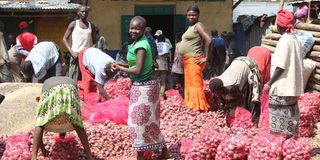Rust diseases in onion production

Women pack onions in Ortum, West Pokot County. Timely planting, spacing and fertilisation can improve the vigour and overall health of onion plants.
The management practices in Desmond’s onions production are in progress. He is applying the cultural methods to control pests and diseases. Chemicals are the last option.
In this article, we look at rust as fungal diseases that affect onion plants.
The diseases are caused by a fungus that typically infests the leaves and stems.
Symptoms of rust diseases are yellow or orange spots on the leaves, which may develop into pulses filled with spores. Heavy infestation causes the leaves to turn brown and eventually die.
The diseases rapidly spread in warm and humid areas. Spores of these rust fungi can be spread by wind, water and human activities such as walking through infected fields or handling the diseased plants.
The spores can survive on plant debris, soil and tools, making it possible for the diseases to spread from one growing season to the next.
Rust diseases have negative effects on onion production. These include reducing yields, depending on the level of infestation.
The quality of the onions is also greatly affected since the diseases can easily cause discolouration and deformation on the leaves, reducing marketability.
High infestation leads to stunted growth, which results in small onions with less ability to compete with weeds.
In addition, the infested plants are susceptible to attack by other diseases and pests, further reducing harvest.
To prevent the spread of rust diseases in onions, it is important to practise good crop management techniques such as rotation, removing infected plant debris and using fungicides when necessary.
It is also important to avoid handling infected plants. Tools and equipment should be cleaned and disinfected between use. The farmer should avoid overhead irrigation in case of infestation.
In some cases, the farmer may consider establishing a barrier crop to prevent the spread of the diseases if the nearby lands are infested.
While planting, the farmer should consider using resistant varieties to rust diseases. Practise crop rotation.
Rotation with non-allium crops such as maize, soybean, wheat or other cereals can help break the disease cycle by reducing the amount of inoculum in the soil.
The field should be kept clean by removing plant debris and weeds.
As a farmer, monitor the crop for any sign of rust diseases and take appropriate measures.
Cultural practices like timely planting, spacing and fertilisation can improve the vigour and overall health of onion plants, making them less susceptible to rust diseases.
Fungicides like copper-based products, mancozeb can be effective in controlling rust diseases.
It is important to follow label instructions and apply fungicides at the recommended rates and timing.
It is also important to note that integrated disease management approaches, which combine cultural, biological and chemical methods, are often the most effective in controlling rust and other onion diseases.
In our next article, we shall look at safe use of chemicals in onion production.




